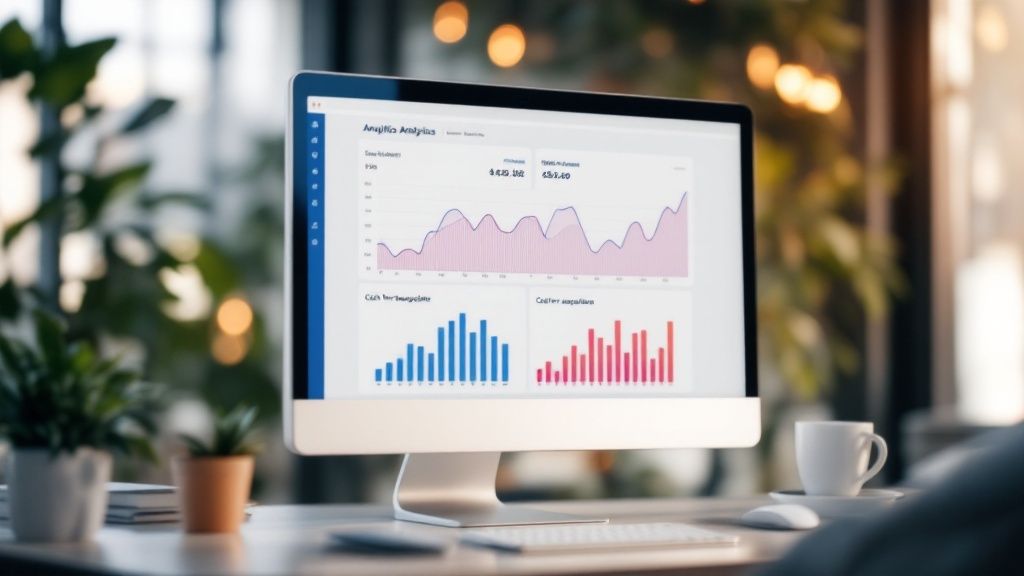In the competitive world of digital advertising, launching Google Ads campaigns is merely the first step. Achieving a high return on ad spend (ROAS) requires a disciplined, structured, and continuous optimization process. Many advertisers fall into the trap of making reactive, surface-level tweaks without a clear strategic framework, leading to wasted budgets and missed opportunities. This is where a comprehensive Google Ads optimization checklist becomes an indispensable tool, transforming your campaign management from guesswork into a data-driven science.
This article provides a strategic blueprint for both seasoned professionals and ambitious marketers. We will dissect eight critical pillars of high-performing campaigns, offering actionable steps to refine your approach and maximize results. From mastering keyword match types to optimizing landing pages and segmenting audiences, each point is designed to deliver immediate, measurable impact.
Prepare to elevate your campaigns by focusing on the elements that truly drive performance. This guide will equip you with the insights needed to not only reduce cost-per-acquisition but also to scale your lead generation efforts effectively. By following this checklist, you will build a resilient, efficient, and highly profitable Google Ads engine that fuels consistent business growth in 2025 and beyond.
1. Keyword Match Type Optimization
At the core of any successful Google Ads campaign is the strategic use of keyword match types. This fundamental element of our google ads optimization checklist determines how closely a user's search query must match your keyword to trigger your ad. Mastering match types allows you to strike the perfect balance between broad reach and precise relevance, ensuring you attract qualified traffic while minimizing wasted ad spend.
Balancing Reach and Relevance
Think of match types as a control dial for your ad visibility. Google now simplifies this into three main types: Broad, Phrase, and Exact Match. Broad Match offers the widest reach but the lowest relevance. In contrast, Exact Match provides the highest relevance by triggering your ad for searches with the same meaning as your keyword, but it has the most limited reach.
- Broad Match: Use sparingly, perhaps with Smart Bidding, for top-of-funnel discovery or to identify new keyword ideas once you've established a solid foundation.
- Phrase Match: A versatile middle ground, showing ads for searches that include the meaning of your keyword. This is excellent for targeting service-related terms where intent is clear but phrasing may vary.
- Exact Match: The gold standard for high-intent, bottom-of-funnel keywords. Use it for specific product names, competitor brands, or "buy now" queries where you want maximum control.
For example, a B2B SaaS company might use Phrase Match for "project management software" to capture relevant searches, while using Exact Match for "[Asana vs Trello]" to target users actively comparing solutions. This layered approach ensures comprehensive coverage across the customer journey.

This visual guide underscores a crucial best practice: allocating the majority of your budget to more controlled match types like Exact and Phrase allows you to build a profitable foundation before exploring broader terms. By segmenting performance, you can make data-driven decisions on where to scale your budget.
Actionable Optimization Tips
To put this into practice, start new campaigns with a heavy focus on Phrase and Exact match keywords. Regularly review your Search Terms Report to see the actual searches triggering your ads. Add irrelevant search terms as negative keywords to prevent future wasted spend and add high-performing queries as new Phrase or Exact Match keywords. This continuous refinement is what transforms a good campaign into a great one.
2. Ad Extension Implementation
Beyond the headline and description, Ad Extensions (now called Assets) are a critical component of any comprehensive google ads optimization checklist. They provide additional information and functionality directly within your ad, effectively increasing its size, visibility, and relevance on the search results page. By enriching your ad with more context and interactive options, you can significantly improve your click-through rate (CTR) and Ad Rank.

Enhancing Ad Visibility and User Experience
Think of Assets as valuable real estate for your ad. They allow you to showcase unique selling propositions, provide direct navigation to key pages, and offer multiple ways for users to engage. Google's algorithm also favors ads that utilize them, as they create a better, more informative experience for the searcher. This often leads to a higher Ad Rank and a lower cost-per-click (CPC).
- Sitelinks: Direct users to specific pages on your website, like "Pricing," "Case Studies," or "Contact Us," shortening the conversion path.
- Callouts: Highlight key benefits or features in short, punchy snippets, such as "24/7 Customer Support" or "Free Initial Consultation."
- Structured Snippets: Provide context by listing features under a predefined header, like "Service Catalog: IT Support, Cloud Migration, Cybersecurity."
- Location & Call Assets: Essential for local businesses, these allow users to get directions or call your business directly from the ad.
A B2B SaaS company, for example, could use sitelinks to guide prospects to a demo request page and a features page. Simultaneously, they could use callouts to emphasize "SOC 2 Compliant" and "Seamless Integration," providing multiple layers of relevant information to a potential client in a single ad impression.
Actionable Optimization Tips
To effectively implement Assets, start by enabling all types that are relevant to your business goals. Aim to have at least four active sitelinks per campaign or ad group. Use callouts to communicate your core value propositions and structured snippets to detail your service offerings. For any business with a physical location, enabling location assets is non-negotiable. Regularly review the performance of your assets in the "Assets" report and test different combinations to discover what resonates most with your audience.
3. Negative Keyword Strategy
Just as important as choosing what to target is deciding what not to target. A proactive negative keyword strategy is a non-negotiable part of any effective google ads optimization checklist, acting as a filter to prevent your ads from showing for irrelevant or low-intent searches. This crucial practice protects your budget from wasted clicks and ensures your ads are seen only by the most qualified potential customers.
Protecting Your Budget and Boosting ROI
A negative keyword strategy is your primary defense against ad spend leakage. It works by telling Google which specific search terms you want to exclude, ensuring your budget is concentrated on queries that align with your business goals. By systematically blocking unprofitable traffic, you directly improve key metrics like click-through rate (CTR) and conversion rate, leading to a higher Quality Score and a better return on investment.
- Campaign-Level Negatives: Use these for terms that are irrelevant across an entire campaign. A law firm, for instance, would add "free," "pro bono," and "job" to avoid attracting users seeking free advice or employment opportunities.
- Ad Group-Level Negatives: Apply these for more granular control. A company selling premium software might add "free" as a negative to its main ad groups but allow it in a specific ad group targeting users searching for "free trial."
- Shared Negative Lists: Create account-wide lists of universal negatives. For a B2B service provider, this list might include terms like "cheap," "DIY," "training," and "examples" to filter out non-commercial search intent.
For example, a Managed Service Provider (MSP) would add negative keywords like "home," "personal," and "resume" to avoid showing ads to individual consumers instead of businesses. This precision targeting is what separates a profitable campaign from a costly one. You can dive deeper into the fundamentals of how these exclusions work and learn more about developing a robust Negative Keyword Strategy for your account.
Actionable Optimization Tips
To implement this effectively, make the Search Terms Report your best friend. Schedule time each week to review this report to identify new irrelevant terms that have triggered your ads. Add these terms as negative keywords immediately. Creating shared negative keyword lists for universal exclusions (like "jobs" or "reviews") and applying them across all relevant campaigns will save time and ensure consistency. This continuous refinement ensures your campaigns become more efficient and profitable over time.
4. Landing Page Experience Optimization
A critical, yet often overlooked, component of any google ads optimization checklist is the user's journey after the click. Sending highly qualified traffic to a poor landing page is like inviting customers into a store with broken shelves and no cashier. Landing page experience optimization is the process of creating a seamless and persuasive pathway from your ad to a conversion, directly impacting your Quality Score, ad costs, and ultimately, your return on investment.

Aligning Ad Scent and User Intent
The core principle is "ad scent," which refers to the consistency between the message in your ad and the message on your landing page. When a user clicks an ad promising a "free consultation for managed IT services," they expect the landing page to prominently feature a form for that exact offer. A disconnect here creates confusion and causes visitors to bounce, signaling to Google that your page provides a poor user experience.
- Relevance: The headline, copy, and imagery on your landing page must directly reflect the keyword and ad that brought the user there.
- Clarity: A user should immediately understand your value proposition and what action they are expected to take next.
- Trust: Professional design, customer testimonials, and clear contact information build credibility and reduce friction in the conversion process.
For instance, an e-commerce store advertising "men's running shoes" should direct users to a specific category page showcasing those products, not the generic homepage. Similarly, a B2B SaaS company should create dedicated landing pages for each feature-specific campaign, ensuring the content speaks directly to the user's initial search query.
Actionable Optimization Tips
To put this into practice, audit your current ad-to-page journeys. Ensure every ad group has a highly relevant landing page. Remove distracting navigation links on lead generation pages to keep users focused on the primary call-to-action. Prioritize mobile-first design and optimize page load speeds, as these are significant factors in Google's ranking algorithm and user retention. Continuously A/B test elements like headlines, call-to-action buttons, and form lengths to methodically improve your conversion rates over time.
5. Bid Strategy and Budget Optimization
Effective bid strategy and budget allocation are the financial engine of a high-performing Google Ads account. This crucial component of our google ads optimization checklist involves selecting the right bidding model to align with your business goals. Mastering this balance ensures every dollar is invested strategically, driving optimal results without exceeding your financial guardrails.
Aligning Bidding with Business Goals
Think of your bid strategy as the instruction manual for Google's algorithm, telling it precisely what outcome you value most. While manual bidding offers granular control, Google's automated Smart Bidding strategies use machine learning to optimize for specific objectives like conversions, revenue, or visibility.
- Target CPA (Cost Per Acquisition): Perfect for lead generation, this strategy aims to acquire new customers at a specific cost. A B2B SaaS firm might set a Target CPA of $150 to ensure new sign-ups remain profitable.
- Target ROAS (Return On Ad Spend): The go-to for e-commerce, this strategy focuses on generating a target amount of revenue for every dollar spent on ads. An online retailer could aim for a 400% ROAS to maintain healthy profit margins.
- Maximize Conversions: Use this to generate the highest number of conversions possible within your daily budget, ideal for campaigns where volume is the primary goal.
For instance, a professional services firm might start with Manual CPC to understand the cost landscape before transitioning to Target CPA once it has collected sufficient conversion data. This methodical approach allows you to harness the power of automation with a clear, data-informed objective.
Actionable Optimization Tips
Begin new campaigns with a more controlled strategy like Manual CPC or Enhanced CPC to establish baseline performance metrics. Once you have at least 15-30 conversions over a 30-day period, you can confidently transition to an automated strategy like Target CPA. When you do, set realistic targets based on your historical data; setting an overly aggressive target can stifle performance. Allow the algorithm a 1-2 week learning period after any significant change. Continuously monitor performance and adjust your targets and budgets to reflect changing market conditions.
6. Ad Copy Testing and Optimization
Even with perfect targeting and bidding, your campaign's success ultimately hinges on the quality of your ad copy. This crucial step in our google ads optimization checklist is the systematic process of creating, testing, and refining your ad messaging to improve click-through rates (CTR), Quality Scores, and conversion performance. Effective testing transforms ad copy from a creative guess into a data-driven driver of results.
Identifying Winning Messages
Ad copy optimization is a continuous cycle of hypothesis, testing, and analysis. The goal is to discover which combination of headlines, descriptions, and calls-to-action (CTAs) resonates most deeply with your target audience. By isolating variables and measuring performance, you can methodically improve your ads' ability to attract qualified clicks and persuade users to take action.
- Headlines: Test different angles. Does a feature-focused headline ("Automated Invoicing Included") outperform a benefit-driven one ("Spend Less Time on Paperwork")?
- Descriptions: Experiment with social proof ("Trusted by 10,000+ Businesses") versus unique value propositions ("The Only All-in-One MSP Platform").
- Calls-to-Action: Compare direct commands ("Get a Free Demo") with urgency-based appeals ("Claim Your Spot Now").
A B2B SaaS company could test a headline highlighting a key integration against one that emphasizes cost savings. A financial services firm might A/B test a CTA like "Download Our Free Guide" against "Schedule a Consultation" to understand user intent at different funnel stages. This iterative process ensures your messaging evolves with market feedback.
Actionable Optimization Tips
To implement effective ad copy testing, leverage Google's Responsive Search Ads (RSAs). Provide a variety of distinct headlines and descriptions, and let Google's machine learning identify the top-performing combinations. You must still guide the process: test one core message or theme at a time for clear results. Be sure to include target keywords naturally in your headlines to boost relevance and Ad Rank. Finally, rotate your ad creative regularly to combat ad fatigue and keep your messaging fresh.
7. Audience Targeting and Segmentation
Beyond keywords, a crucial part of any effective google ads optimization checklist is layering in audience targeting. This strategy allows you to define who sees your ads, not just what they search for. By segmenting users based on their demographics, interests, and past interactions with your business, you can deliver highly tailored messages to the people most likely to convert, dramatically improving your campaign's efficiency.
Moving Beyond Keywords to People
Think of audience targeting as adding a powerful filter to your campaigns. While keywords capture user intent at a specific moment, audiences provide context about the person behind the search. Google Ads offers a rich set of options, from broad in-market segments to highly specific remarketing lists, allowing you to engage users at every stage of their journey.
- Remarketing Lists: Re-engage users who have previously visited your website. This is perfect for nurturing leads or recovering abandoned shopping carts.
- In-Market Audiences: Target users who are actively researching and considering products or services like yours. This is ideal for capturing bottom-of-funnel interest.
- Custom Audiences: Build your own audiences based on specific search terms, visited URLs, or app usage, giving you granular control.
- Customer Match: Upload your list of existing customers to either re-engage them with new offers or exclude them from acquisition campaigns to improve efficiency.
For example, a B2B SaaS company can use a custom audience to target users who have searched for competitor software, layered with demographic targeting to reach only those in C-suite or managerial roles. Similarly, a professional services firm might use a remarketing list to show a testimonial video ad to users who visited their "case studies" page but didn't submit a contact form.
This visual guide emphasizes a critical principle: starting with your most valuable audiences, like past website visitors and existing customers, builds a strong foundation for profitability. You can then strategically expand your reach to broader in-market or custom audiences as you gather performance data.
Actionable Optimization Tips
To implement this, start by adding relevant audiences to your existing search campaigns in "Observation" mode. This allows you to gather performance data without restricting your reach. Review the performance of each audience segment and apply positive bid adjustments to those that convert well, or negative adjustments to those that underperform. For your most valuable segments, create dedicated campaigns with tailored ad copy and landing pages to maximize conversion rates.
8. Performance Monitoring and Analytics Setup
Operating a Google Ads campaign without robust performance monitoring is like flying a plane blind. This critical element of our google ads optimization checklist involves implementing comprehensive tracking to measure what truly matters. By accurately tracking conversions and integrating analytics, you transform raw data into actionable insights, enabling data-driven decisions that directly impact your bottom line.

From Clicks to Conversions
Effective monitoring goes beyond simply tracking clicks and impressions. It means connecting ad spend to tangible business outcomes. This is achieved by setting up conversion tracking within Google Ads and linking your account to Google Analytics 4 (GA4). This dual setup provides a holistic view of the user journey, from the initial ad click to the final conversion event.
- E-commerce: Track key actions like purchases, "add to cart" events, and newsletter signups to understand the full value driven by your campaigns.
- Lead Generation: For a B2B or service business, monitor form submissions, phone calls from ads, and demo requests to measure lead volume and quality.
- SaaS Companies: Focus on tracking trial signups, subscription conversions, and key in-app actions to connect ad performance to user acquisition.
For instance, a managed service provider (MSP) can track how many users who clicked an ad for "outsourced IT support" went on to fill out the "Get a Quote" form. This data allows them to calculate the exact cost per acquisition and optimize bidding strategies for campaigns that generate the most valuable leads.
Actionable Optimization Tips
Set up conversion tracking for all meaningful actions on your website before launching any campaigns. Use Google Tag Manager to streamline the implementation of tracking codes and pixels, which simplifies management and reduces reliance on developers. Create custom reports in GA4 or Looker Studio that focus on your primary KPIs, filtering out the noise. Finally, set up automated alerts for significant performance changes, such as a sudden drop in conversion rate, to address issues proactively.
From Checklist to Competitive Advantage: Your Next Steps
You've just navigated a comprehensive Google Ads optimization checklist, moving from foundational keyword strategy to advanced audience segmentation. It's easy to feel overwhelmed, but the true power of this guide lies in embracing its core philosophy: proactive, continuous improvement.
This checklist is more than a to-do list; it's a strategic framework for transforming your Google Ads account into a dynamic engine for client acquisition. The most successful companies don't just "set and forget" their campaigns. They treat them like a living system, constantly feeding them data, testing hypotheses, and refining their approach. This is the mindset that separates average results from market-leading performance.
From Theory to Tangible ROI
Let's distill the journey into its most critical takeaways. A powerful Google Ads strategy rests on a few key principles:
- Precision Over Reach: Mastering keyword match types and building a robust negative keyword list isn't about limiting your visibility. It's about focusing your budget on the most qualified, high-intent prospects.
- User Experience is Paramount: A high-quality ad is only half the battle. Your landing page experience is where conversions happen. Optimizing for speed, clarity, and a strong call to action ensures you don't waste expensive clicks.
- Data-Driven Decisions are Non-Negotiable: Moving from manual to automated, value-based bidding strategies and constantly split-testing ad copy are essential actions for maximizing your return on ad spend (ROAS). Without accurate conversion tracking, you’re simply guessing.
By systematically addressing each of these eight areas, you create a powerful feedback loop. Better targeting leads to more relevant clicks, which provides cleaner data, which in turn informs smarter bid strategies and more effective ad copy. This cycle is the engine of optimization.
Making the Checklist a Habit, Not a Project
The most significant mistake advertisers make is treating optimization as a one-time project. The digital marketplace is not static. Your google ads optimization checklist should become a recurring part of your marketing rhythm.
Consider scheduling a monthly or quarterly review dedicated to running through these points. One month, your focus might be a deep dive into your negative keyword lists. The next, you might run A/B tests on your primary landing pages. This consistent, iterative process ensures your campaigns never grow stale and are always adapting.
Key Insight: True optimization isn't about achieving a "perfect" account. It's about building a resilient, adaptable system that consistently learns and improves over time, turning your advertising spend into a predictable and scalable source of growth.
Ultimately, mastering this checklist gives you more than just better campaign metrics; it provides a competitive advantage. While your competitors are struggling with wasted spend and unclear results, you will be operating with the clarity and efficiency that comes from a well-oiled, data-backed advertising machine. You will be able to confidently scale your budget, knowing that every dollar is being deployed as effectively as possible.
Ready to turn this checklist into a sustained competitive advantage but lack the time or in-house expertise to execute at an expert level? The team at Twelverays specializes in implementing these advanced optimization strategies for B2B and professional services firms, transforming Google Ads accounts into powerful client acquisition systems. Schedule a consultation with Twelverays today to discover how a data-driven approach can unlock your next stage of growth.





